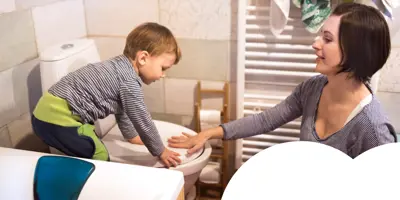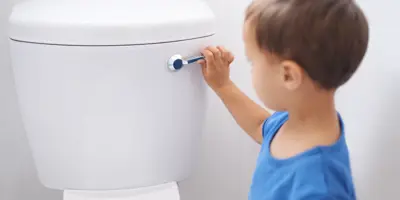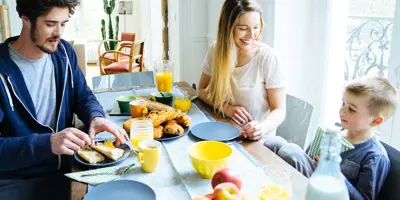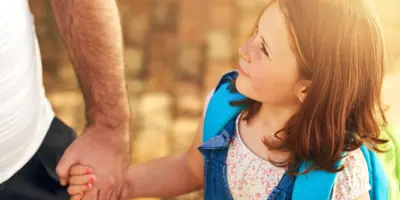1 person found this helpful

Potty training is potentially one of the toughest early challenges of parenting. Yet it’s also one of the biggest steps your little one will take towards independence, and there’s something pretty special about that. The important thing is to be patient, and to be kind to yourself, too. You’ll both get there in the end.
At what age should kids learn to use the bathroom?
Healthy children aren't physically and emotionally ready to start using a potty until they are between 18 months and three years old.
That said, it’s best to ignore age and how other children are faring (that way lies madness) and focus on whether your little one is showing signs that they’re developing bladder control, such as:
- Knowing when their nappy is wet or dirty.
- Knowing they’re doing a wee or a poo (and maybe telling you they’re doing it).
- Staying dry for at least an hour at a time.
- Fidgeting or going somewhere quiet or out of sight when they need to wee.
- Telling you when they need to wee. This is the surest sign of readiness for potty training in children.
How to help kids learn to use the potty
Now that you know when to start potty training, it’s time to begin! There’s no golden formula for potty training, but certain things can help your little one along.
Before potty training starts:
- Help your child learn to associate wee and poo with being in the bathroom. Try to change their nappy in your bathroom at home.
- Talk to your child as you change them. Tell them what you’re doing, and why you’re doing it.
- Pick out a potty with your child – they’re more likely to use one they like – and put it in the bathroom. Let them get used to having it around.
- Demonstrate how to use the potty. Kids often learn through copying others. When the potty is new and clean, try acting out going to the bathroom using toys, or go to the toilet with the door open for a while so they understand how you’re using it.
- Let them practice – and make it easy. When they’re new to their potty, learning to sit down and stand up from it is an important first step. If you need to use a child’s toilet seat instead of a potty, keep a stool nearby so they can easily reach the toilet and rest their feet on it as they use it.
- Make it as comfortable as you can. Make sure your bathroom is well stocked with everything they need once they start using the potty, all within easy reach. Try to get a soft and absorbent toilet paper like Cushelle, so wiping feels comfortable and luxurious.
- Get the whole family on board. Potty training is not only the responsibility of both parents, but of older siblings too. Big brothers and sisters are the most recent potty-training graduates in the household, so they are best placed to understand how their smaller counterparts are feeling. Encourage them to be supportive role models for your toddler to look up to – they’ll be proud to take on the responsibility.
- Put up a poster to show them how it’s done. You can remind kids what to do when they’re in the bathroom with a simple poster – it’s an easy way to encourage them to use the potty when they’re alone in the bathroom.
To begin potty training:
- Stop using nappies... When it’s time to start using the potty for real, you’ll need to stop using nappies and pull-ups straight away – otherwise, kids can find it difficult to tell when they’re wet or dirty, and have no obvious reason to use the potty. Help your little one pick out some new underwear, and buy plenty – accidents will happen while they’re still learning.
- … except during the night. At first, focus on helping your little one learn to use the potty during the day, and continue to use nappies at night. Once they’ve mastered day-time use, and the nappies are usually dry in the morning, you can switch to waterproof sheets. The important thing to remember about potty training at night is to make it easy to use the bathroom. Set up a night light and make sure they don’t have to go very far.
- Make it easy to undress. Pick out clothes that are easy to pull up and down, and help your child practice dressing and undressing to use the potty.
- Don’t worry about helping boys go standing up yet. To start with, teach boys to wee sitting down; this makes it less likely that they’ll forget to poo as well, which can easily happen at the start of potty training. It might also help them empty their bladders better. They will learn to wee standing up once they’re able to use the toilet by themselves, especially if they’ve been able to watch Dad.
- Be patient and prepared. Accidents are inevitable, but they’re nothing to worry about. Building your little one’s confidence is the key, so make sure they know they’re not in trouble. Just have a roll of soft and absorbent Cushelle toilet paper to hand, so that spillages can be mopped up quickly, calmly and with minimal fuss.
- Settle on a routine. This can help kids get into the habit of using the potty regularly, especially because they might not realise they need to wee or poo to start with. Try having them sit on the potty once every couple of hours for 2-3 minutes, keeping some (ideally washable) toys nearby so they’re happy to sit still.
- Be positive! A little praise can go a long way. Congratulate your child when they successfully sit on the potty and get dressed, and reward them for potty cleanliness when they wipe themselves properly and wash their hands. Consider setting up a sticker chart so they can see their progress, and so that you and your partner are both on the same page, regardless of who’s on potty duty that day.
Go for a toilet paper that’s soft and absorbent, like Cushelle.
Finally, the most important lesson for you as a parent: go easy on yourself! There are bound to be some messy accidents to start with; it’s part of learning how to use the potty, after all. If your little one seems to have trouble at first, don’t worry: just switch them back to nappies and try again after a few weeks. Best of luck!
Related articles
The potty-to-toilet transition: 7 essential toilet training tips
Do you think your child is ready to make the transition from potty to toilet? Read this guide for toilet training tips from the experts at Cushelle.

Potty Training Tips: How to Potty Train a Boy
Want to know the best age to potty train a boy, or how potty training boys differs from girls? Read on for the essential potty-training tips for boys.

5 Tips for Night-Time Potty and Toilet Training
With these 5 tips on how to potty train at night your little one will soon be dry and you can wave goodbye to middle-of-the-night nappy changes. Click for more.

What's the Right Age to Start Potty Training?
Is there a 'good' age to potty train? Cushelle answers all your questions about how to know when your child is at potty-training age. Click for more.

How to craft the perfect morning routine for school
Does your morning routine for school always end up in everyone leaving the house late? Read on for tips to help you to craft the perfect morning routine.

What Should a Child Know Before Starting School?
Is your child starting school this year? Here’s how to prepare, including teaching about hygiene and personal care. Click to find out more.



